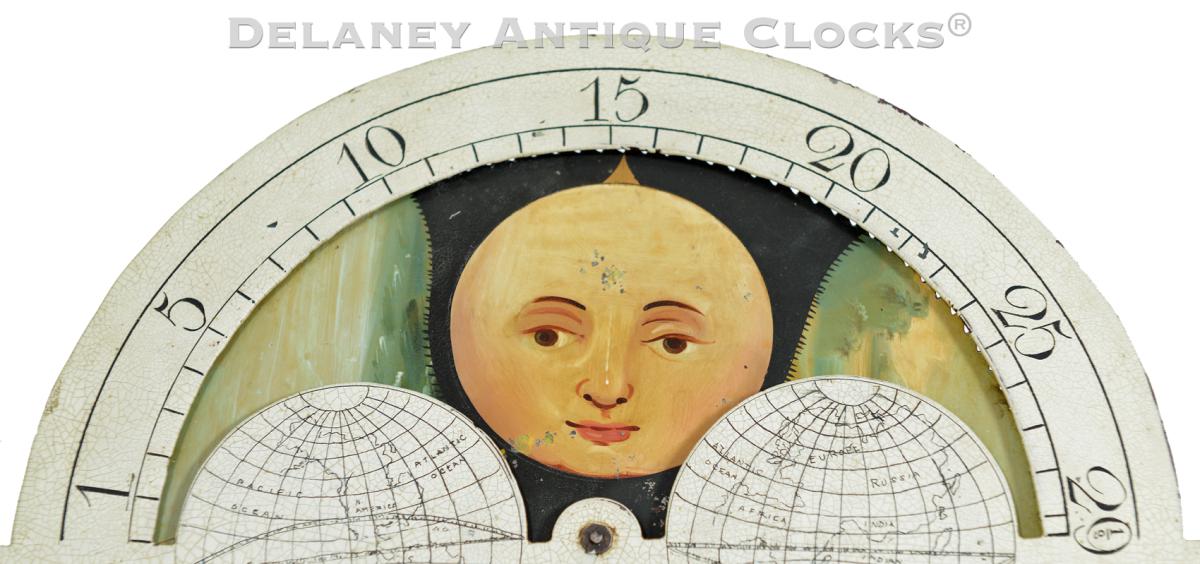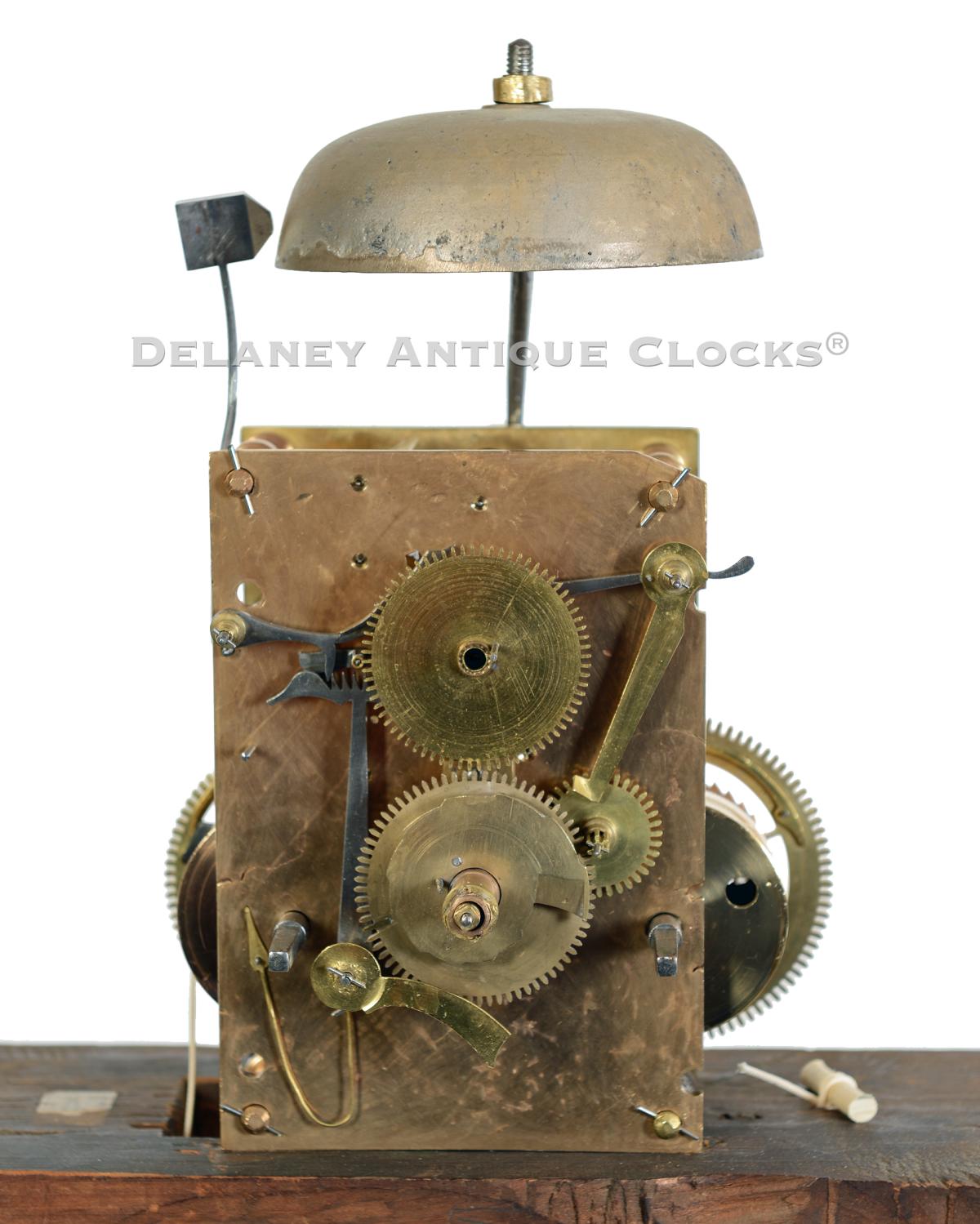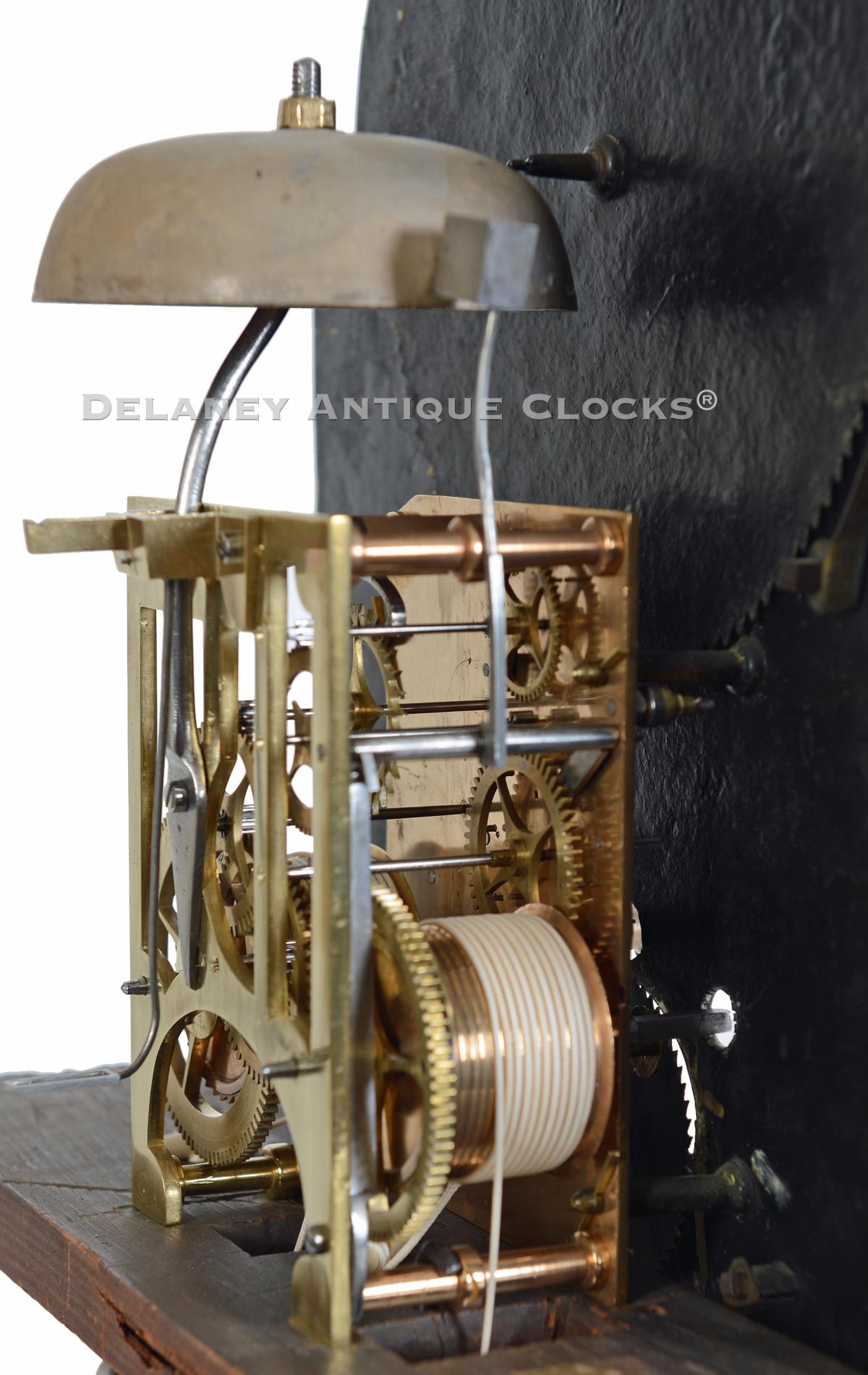Attributed to Calvin Bailey of Hanover, Massachusetts, This inlaid mahogany tall clock features a case believed to be made by Theodore Cushing of Hingham. 224086.
This clock, attributed to Calvin Bailey of Hanover, Massachusetts, carries with it a rich historical significance. The case maker is believed to be Theodore Cushing of Hingham, adding another layer of historical depth to this remarkable piece.
This is a beautiful example of one of Calvin Bailey's more ambitious productions. Calvin Bailey did not make the cabinets for his clocks, but local cabinetmakers did this work. This example is thought to have been made in the Hingham workshop of Theodore Cushing. Theodore Cushing specialized in making clock cases. This cabinet stands out, having stately proportions and an outstanding inlay design. What makes this example so notable is the complexity of the inlay display. A similar plain example with a painted dial signed by Calvin Bailey is pictured in Harbor & Home. Furniture of Southeastern, Massachusetts 1710 -1850, written by Brock Jobe, Gary Sullivan, and Jack O'Brien on pages 255-256. We have also owned as many as four additional, more complex examples. One featured a dial signed by John Bailey II, another was attributed to Ruben Tower due to movement construction and family folklore, and two others had unsigned dials. One last example worth mentioning is a Bailey-signed example in the Colonial Williamsburg Collection. These examples shared several similar construction details and designs that suggest they were produced by the same hand. Apart from the similarity in their case proportions, several featured a bold interpretation of an ogee-bracket foot, often with an aggressive spur return. One or two shared a distinctive fretwork pattern, a bold interpretation of an ogee-bracket foot, often with an aggressive spur return. The stop fluting in the bonnet and waist quarter columns was made with contrasting light wood instead of the traditional brass rods favored in Roxbury and Boston. Several examples were decorated with fancy inlays.
This clock is a striking example of intricate craftsmanship. The case, made of well-figured mahogany, boasts long sweeping grain patterns and a variation in tones. Multiple patterns of light wood inlays adorn the case, adding to its visual appeal. The original finish, recently lovingly rubbed out, further enhances its beauty.
The case stands on four boldly formed applied ogee bracket feet, each featuring an aggressive spur return. The base panel is a masterpiece in itself, featuring a beautiful selection of figured mahogany. The grain pattern spirals down like a whirlpool into the lower right corner, creating a captivating visual effect. A light line inlay forms a box whose corners are fitted with an inlaid tulip within a green field. The panel center is inlaid with a multi-colored, two-handled urn, adding to the panel's unique design.
The waist section is long and accentuates the narrow proportions of the case. The waist door is rectangular and trimmed with applied molding around its perimeter. The mahogany wood selected for this location features an attractive grain pattern. This door shares the inlay formatting used in the base panel except for the center inlay, modeled after Prince-of-Wales's feathers. One can access the two drive weights and brass-faced pendulum bob through this door. The front corners of the case are fitted with fluted quarter columns that terminate in brass quarter capitals. The columns are stopped or inlaid with light wood, where one would expect brass stopped fluting. Under the columns are plinths decorated with an inlay pattern with an urn, and a long flowering plant. The bonnet features a traditional New England-style lacy fretwork pattern. The three inlaid finial plinths that support the frets are decorated with inlays. Each supports brass ball and spike finials. The inlaid bonnet door is arched and fitted with glass. The frame is lined inlaid with an alternating light and dark wood pattern. Fully turned and fluted bonnet columns flank it. These share the same design used in constructing the waist columns, mounted in brass capitals, and are also stopped with light wood.
The door opens to reveal a finely painted dial of Boston origin, a testament to the clock's historical significance. The dial features a moon phase disk in the lunette, beautifully painted with detailed scenes. One side depicts a serene landscape with a stone cottage, while the other shows a bustling shoreline with a large sailing ship. At the base of the lunette are two hemispheres, each decorated with hand-painted terrestrial maps, a rare method found on some of the earliest painted dials made in this country. The perimeter of the moon phase aperture is adorned with a brightly gilt border, adding to the dial's visual appeal.
This painted iron dial was made in Boston. It is a product of one of the Spencer Nolen dial painting firms. The highlights are the four American shields in the spandrel areas. These are raised off the dial surface with applied gesso highlighted in gilt paint. These are excellent. The dial features an automated paint-decorated moon phase disk in the lunette. It is decorated with hand-painted scenes and moon faces. One side of the moon disk depicts a coastal scene with a cottage, and the other is a frigate at sail. At the base of this lunette are two hemispheres decorated with detailed terrestrial maps. This dial also displays the traditional format's hours, minutes, seconds, and calendar dates.
The brass movement, which is of eight-day duration, is constructed with a 'skeletonized' back plate. 'Skeletonized' refers to those clock movements that have the unused portions of their brass plates cut away, creating a distinctive pierced, skeleton-like appearance. This technique, developed by John Bailey II and his brother Calvin, was a thrifty way to diminish the waste of expensive brass. These early clocks with skeletonized movements are directly associated with John Bailey Jr. II (1751-1823). John was not only the first known clockmaker from this area, but he was responsible for training the important group of makers who would flourish in this region during the ensuing 19th Century. The movement is fitted with an original steel shaft pendulum with a brass-capped lead bob and cast iron drive weights. The movement rests on a wooden 'saddle board', a unique feature of this clock, and is original to the case. The movement has recently been serviced and is in excellent running condition.
This clock was made circa 1805. This case stands approximately 7 feet 9 inches tall to the top of the center finial, 20 inches wide, and almost 10 inches deep.
Inventory number 224086.
This clock is sold fully serviced and in excellent working order. The movement has been completely disassembled and cleaned. Areas of wear are addressed while the movement is rebuilt. The movement is then lubricated and tested to ensure its performance.
Calvin Bailey was born in Hanover, MA, the son of John (A shipbuilder) and Ruth Randall Bailey on May 6, 1751. He died in Bath, Maine, in 1835. He was into Southeastern Massachusetts's most prominent clockmaking family. He was a Quaker and one of six members of the Bailey family that were involved in clockmaking. Calvin lived in a time when business was often conducted in the barter system. He was often taking in goods in trade for his clocks or services. Calvin and his brother Lebbeus 91763-1827)learned the art of clockmaking from their older brother John Jr (b. 1751-d.1823). We are fortunate in that Calvin's work ledger exists. It records that Calvin made clocks year-round but was also very involved in farming. It also records that he did business with four local cabinetmakers. They include Ells Damon, Theodore Cushing, Abiel White, and Abner Hersey. A number of Calvin's clockworks are housed in cases made by Cushing and White. Calvin moved from Hanover to Bath, Maine, in 1828.




















